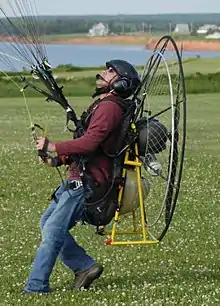Paramotor
Paramotor is the generic name for the harness and propulsive portion of a powered paraglider ("PPG"). There are two basic types of paramotors: foot launch and wheel launch.


Foot launch models consist of a frame with harness, fuel tank, engine, and propeller. A hoop with protective netting primarily keeps lines out of the propeller. The unit is worn like a large backpack to which a Paraglider is attached through carabiners.
Wheel launch units either come as complete units with their own motor, or as an add-on to a foot launch paramotor. They usually have 3 (trike) or 4 (quad) wheels, with seats for one or two occupants. These should not be confused with powered parachutes which are generally much heavier, more powerful, and have different steering.
The term was first used by Englishman Mike Byrne in 1980[1] and popularized in France around 1986 when La Mouette began adapting power to the then-new paraglider wings.
Power plants are almost exclusively small two-stroke internal combustion engines, between 80 cc and 350 cc, that burn a mixture of gasoline and oil. These engines are favored for their quick high r.p.m. thrust and low weight, using approximately 3.7 litres (1 US Gal.) of fuel per hour depending on paraglider efficiency, the weight of unit plus pilot, and flying weather conditions. At least one manufacturer is producing a 4-stroke model favored for its strong lower r.p.m. thrust and better fuel efficiency. Electrically powered units also exist, though flight duration is considerably limited on the battery's electrical capacity. Csaba Lemak created the first electric PPG, flying it first on 13 June 2006.[2][3] Wankel rotary engined paramotors are also available, but rare.
The pilot controls thrust via a hand-held throttle and steers using the wings brake toggles or stabilo steering, weight shifting or a combination of the three. It is identical to Paragliding except it is powered so the use of an elevation or thermals to ascend are not required. Paramotor wings have evolved specifically for use with power propulsion, as compared with free flight 'paraglider' wings. Such wings are typically designed for a higher speed and may incorporate a "reflex" profile to aid stability in pitch, an idea taken from hang gliders of the 1980s and developed and pioneered by British designer Mike Campbell-Jones. Paramotor wings typically use trimmers to adjust the Angle of attack of the wing to either slow it down or speed it up in flight. Trimmed out allows the pilot to achieve maximum speed, while trimmed in allows for slower speeds optimized for launching and landing. Generally the trimmers act on the rear of the wing. The angle of attack can also be adjusted by a pully style system, which is activated via a bar pushed by the pilots feet, called a speedbar. This system generally acts on the leading edge of the wing. This system is only activated in-flight, and by default is not activated on takeoff or landing. Due to the torque effect of a motor, this can cause the glider to turn, especially under hard acceleration. Trimmers can be adjusted un-equally to negate this effect.
The most difficult aspect of paramotoring is controlling the wing (paraglider) on the ground. This control is both during launch and upon landing. Initial training in becoming a paramotor pilot involves managing the wing in the air from the ground without the motor. This process is called kiting and is the most complicated and important step in the process. Once kiting the wing on the ground is mastered then the motor is added to the process to practice with the weight of the paramotor included. A typical paramotor will weigh on average around 50 lbs. (23 kg) with some models as light at 40 lbs. (18 kg) and some models as high as 75 lbs. (34 kg.) The size of the paramotor wing and engine are dependent on the weight of the pilot.
The larger the pilot, the larger the size of the wing and thrust required to launch. Most individuals in reasonably good health can foot-launch a paramotor and there are even pilots with artificial joints foot launching. Individuals that may have issues with the physical aspect of foot launching may opt to add a trike or quad to their paramotor. A trike or quad is a platform to which the paramotor can be attached so it can be launched from wheels like a regular aircraft or powered parachute.
This sport has evolved and now many advanced pilots perform extreme maneuvers such as wing-overs, barrel rolls and loops. These types of maneuvers present a significant danger as any type of negative G's encountered will unload the wing allowing the wings lines to go slack. Only very advanced pilots with years of experience, training and coupled with countermeasures such as reserve parachutes should attempt such maneuvers. A reserve parachute is a highly recommended piece of equipment which may prevent significant injury or death in the presence of a malfunction of the equipment or a mistake made by the pilot.
References
- Goin, Jeff (2006). Dennis Pagen (ed.). The Powered Paragliding Bible. p. 253. ISBN 0-9770966-0-2.
- "Marks Paragliding Pages". First Electric PPG. Mark Andrews. 2006-06-13. Retrieved 2007-01-25.
- "Electric PPG Questions". Electric Paramotor Website. Airhead Creations. 2006-06-25. Retrieved 2007-01-25.